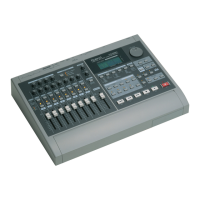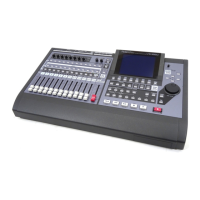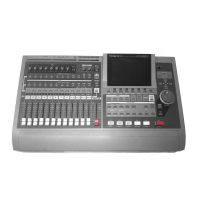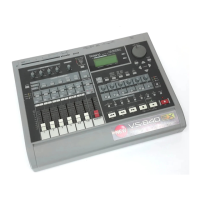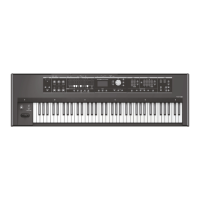2—Getting Around
40 www.RolandUS.com Roland VS-2400CD Owner’s Manual
3—F Buttons 1-6
The F 1-6 buttons are “soft” buttons whose job changes depending on what you’re
doing. When an F button is active, its current function is shown on the display above
the button. For more on how the F buttons work, see Page 66.
In addition, when you hold down SHIFT, the F buttons display a variety of menus and
screens:
4—HOME•DISPLAY Button
Press the HOME•DISPLAY button to return to the VS-2400CD’s Home screen,
described in detail in Chapter 8, beginning on Page 115. Hold SHIFT and press the
button to change what appears in the playlist area of the Home screen (Page 120).
5—CONTRAST Knob
The CONTRAST knob allows you to change the contrast of the VS-2400CD’s display.
Turn the knob until the display looks its best from your viewing angle.
Hold down SHIFT and press: To display:
F1 (PROJECT) the PROJECT menu. When you press PROJECT, a
menu appears in which you’ll find an assortment of
project-management tools and tools for working
with your internal IDE drive.
F2 (TRACK) the TRACK menu that contains the TRACK region
and phrase editing sub-menus.
F3 (EFFECT) the EFFECT menu to set up the VS-2400CD’s
internal effects. Chapter 5 discusses important
underlying effects concepts. Chapter 16 provides
the specifics on using the VS-2400CD’s internal
effects.
F4 (UTILITY) the UTILITY menu. The UTILITY button provides
access to the UTILITY menu, which offers a wide
variety of settings that determine the behavior of
the VS-2400CD. See Chapter 27, starting on
Page 353.
F5 (WAVE DISP) the wave display screen that allows you to view the
currently selected track’s audio as a detailed
waveform rather than a simple rectangle.
F6 (MARKER) the Marker window in which you can create, clear,
and recall markers.
IDE drive, waveform
VS2400OMUS.book 40 ページ 2006年2月28日 火曜日 午前11時12分

